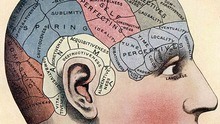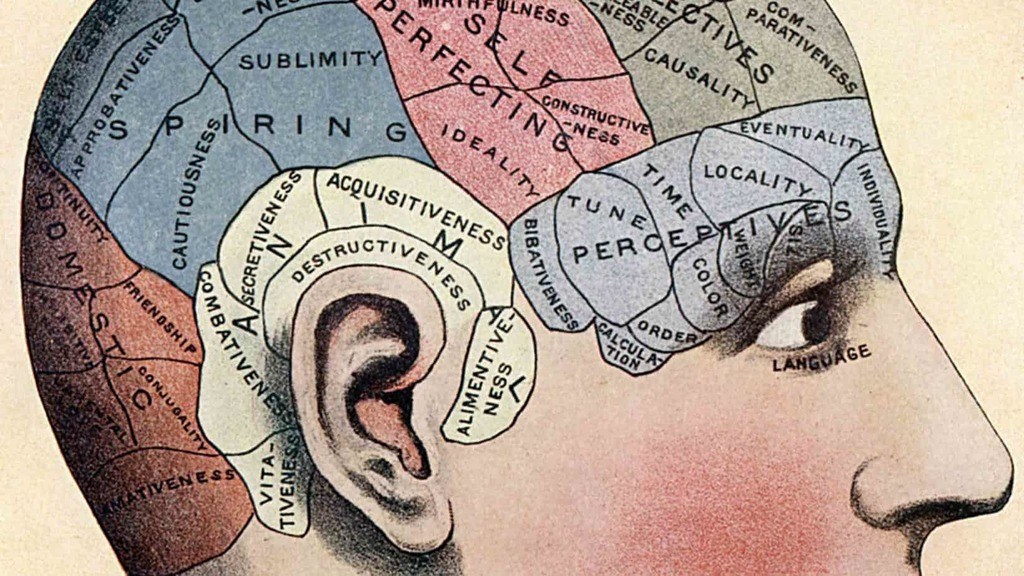How To Rewire Your Brain In 30 Seconds

Unfortunately, our brains are wired for negativity, but you can rewire your brain to make your life upbeat and positive in just 30 seconds a day.

Phrenology chart, showing presumed areas of activity of the brain, c1920. Phrenology was a theory, propounded by the German physician Franz Joseph Gall in around 1800, that you could judge a person’s emotional and intellectual characteristics by the shape of their cranium. Although not based on fact, the theory became extremely popular. (Photo by Oxford Science Archive/Print Collector/Getty Images)
Before we get to how to rewire your brain in 30 seconds, let’s check how it’s currently wired. For this, I rely on the work of , Jeff Haden , Joel Wong and Joshua Brown, and as you’ll see in the uplifting video below, Dr. Srikumar Rao.
It all begins with a common scenario.
Say you meet someone at a dinner party. She’s a vice president of a company that makes a product you happen to know a lot about. The two of you launch into the intricacies of this product, and she gives you the sense that she values your perspective; in fact, as the evening winds down, she suggests that the two of you get together for lunch to discuss this topic further and asks that you email her some dates you’re available.
You do just that.
Days go by.
Crickets.
At this point, what’s going through your mind?
Most likely, what’s going through your mind is a torrent of negative thoughts:
- “Did she really think my ideas sucked, but was just being nice?”
- “Did I dominate the conversation?”
- “Did I make myself too available in that email I sent?”
The Power of Negative Thinking
What’s going on in your head is a bunch of negative thinking. Unsurprisingly, neuroscientists have a name for this automatic habit of the brain: “the negativity bias.” This is an adaptive trait of human psychology that served us well when we roamed the savanna 120,000 years ago chucking spears at tasty looking ruminants. Back then, our lives hinged on the capacity to ascertain the risks of any action, because one of those four-legged, half ton beasts you’re hunting might trample you into a red lump.
Nowadays, this is an unlikely outcome.
In modern times, this negative reacting habit of the brain leaves us reacting to an unanswered email or difficult conversation like our life was in danger. It activates a cascade of stress hormones and leaves us fixated on potential threats, leaving us unable to see the bigger picture.
In his bookBuddha’s Brain, neuroscientist Rick Hanson has a great analogy for this strange quality of the mind:
“Your brain is like Velcro for negative experiences and Teflon for positive ones.”
As Hanson writes, we’re built that way, literally, because negative stimuli produce more neural activity in the brain than positive stimuli. Negative events are also quickly stored in your long-term memory. Not so with positive events; for those you need to actively think about them for twelve seconds or more in order for them to be transferred to your long-term memory. That’s unfair, but true, and is the reason that the wonderful day you were having turns to crap so easily, perhaps by just one slightly negative event.
When you lose a client, when your significant other doesn’t call you when anticipated, or when you face the many other daily disappointments of life, your brain is wired to forget all the good things in your life and instead obsess over the negative.
In order to rewire your brain, that hardwired neural dance needs to be disrupted.
Rewire Your Brain in 30 Seconds (The ultra-efficient transformation of Notice-Shift-Rewire)
How can we reverse this hard-wired, negativity-laced habit of the mind?
Three actions:
- Notice
- Shift
- Rewire
As you’ll see in a moment, this is a simple technique that embraces a seminal insight that emerged from the neuroscience revolution of the last 30 years, which neuroscientist Donald Hebb summarized with this pithy comment:
“Neurons that fire together, wire together.”
This insight reminds us that the brain isn’t fixed. Its habits aren’t like concrete, but more like plastic — sufficiently strong to resist the occasional push or prod, but pliable enough to change in response to repeated effort.
This “brain plasticity” is what enables the Notice-Shift-Rewire to be so effective, if it becomes your daily practice. (The prod needs to be often repeated.) You need to set aside that 30 seconds each day where your mindful intention takes the reins. Step by step, we build the habit of shifting out of “negativity bias” to more useful and empowering mindset:
- Recounting past achievements
- Celebrating strengths and perseverance
- Reflecting on those who love us
Those self-empowering thoughts remind us that life is a series of opportunities, rather than an unrelenting stumble over setbacks and heartbreak.
How do you integrate the practice of Notice-Shift-Rewire into the midst of everyday life?
1. Notice the “negativity bias”
The first step is to bring awareness to this ordinary habit of the mind. This is done by becoming mindful. You must disrupt the reflexive, knee jerk reaction to whatever person, place, thing or event causes such a response. Before you can rewire your brain you must first notice when self-doubt, anxiety and fear slips into your consciousness. You must notice when your mind plays out dire, worst case scenarios about how any particular thing will play out.
2. Shift to a moment of gratitude
Noticing the negativity bias opens the door and invites new neural pathways to light up in your brain. Then the “shift” happens when your focus on positive thinking generates positive outcomes. A good method for that is a Gratitude Practice.
This has been helpful to me. Right after I awaken, I shuffle to my desk, open my gratitude journal and write down three things for which I’m grateful, and what the day’s core intent will be, whether it be something that needs to be done, or an attitude I wish to be mindful of throughout the day. Then I grab my cell phone and speak these things into a voice-to-text note. Speaking what you wrote out loud increases its gravity.
- Gratitude unshackles us from negative emotion. The fewer negative words and thoughts people use, the more likely they are to report better mental health.
- Gratitude helps even when you don’t share it. A study showed that the mental health benefits of writing gratitude letters were not dependent on actually communicating that gratitude to the indented recipient, indicating that just the act of writing down that for which we’re grateful has a positive emotional impact.
- Gratitude’s benefits take time. Sometimes many iterations of daily gratitude work are needed to have a snow ball effect, which winds up insinuating positivism into other aspects of your life.
- Gratitude has lasting effects on the brain. An fMRI scanner showed that those with a Gratitude Practice exhibited greater activation in the medial prefrontal cortex when they experienced gratitude, an indication that simply expressing gratitude may have lasting effects on the brain.
3. Rewire your brain
You’ve noticed your negativity bias about some person, place, time or event. Then you shifted to gratitude. Now the real work of begins. Neuroscientist Rick Hanson calls this the simple act of savoring. You do this by simply bathing in this new mindset for 15 seconds. You need to encode it deep into the fabric of your mind.
This final step in your 30 second check-in to rewire your brain is where we transform our ordinary habit of knee-jerk negativity bias into positivism. We flip the switch on our evolved neural wiring from negative to positive — taking just a few seconds to build stronger memories around all the good things happening in life.
The best thing about this brain rewire practice is that its time efficient, portable, and powerful. I mean, who doesn’t have 30 seconds? Of course you have that much time, but what you’ll need to work on is the mindful state of mind to catch and rewire the negativity bias.
The moment you make this shift, many things can change. Perhaps your life’s purpose will come into focus. Perhaps you’ll forgive someone and lighten your own burden. Perhaps those challenges that you soon face will appear exciting.
And now, get pumped up by watching Dr. Srikumar Rao show you how to stop negative mental chatter and never get angry again:
So, now you have some tools in your mindset tool box. I leave it to you to rewire your brain with Notice-Shift-Rewire once a day, every day for a week, and then see what happens. May your life be filled with renewed optimism.
Last Updated on February 3, 2024 by Joe Garma





